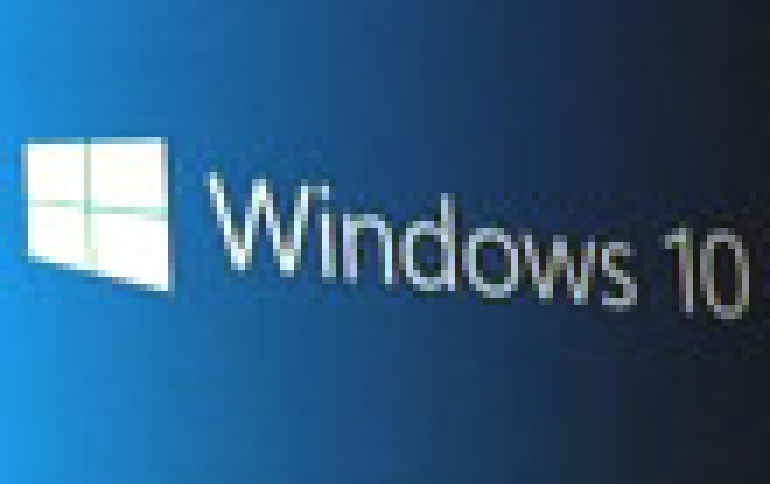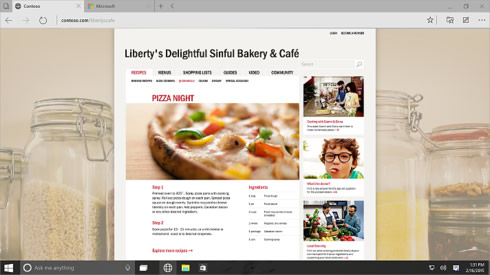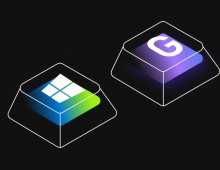
A Look at Microsoft's New Spartan Browser
Yesterday, Microsoft announced that Windows 10 will ship with a brand new browser, codenamed "Project Spartan," a modern browser that seems to be capable of matching the appeal of Google’s Chrome and Mozilla’s Firefox. Designed for Windows 10, Spartan brings advanced features including the ability to annotate on web pages, share thoughts through e-mail and social media or save them to the cloud, a distraction-free reading experience, and integration of Cortana -- Microsoft’s voice-enabled personal search assistant -- for finding and doing things online faster.
Spartan is a single browser designed to work great across the entire Windows 10 device family - from keyboard and mouse on the Windows 10 desktop to touch, gestures, voice, controllers and sensors.

Powered by a new rendering engine, Spartan is designed for interoperability with the modern web. The browser moves away from the versioned document modes historically used in Internet Explorer, and now uses the same markup as other modern browsers. Microsoft says the legacy document modes will be primarily limited to Enterprise legacy web apps. Spartn, however, will still honor document modes served by intranet sites, sites on the Compatibility View list, and when used with Enterprise Mode only.

The cornerstone of the new browser is the "Edge" mode platform-a new document mode designed with interoperability at its core.
Public Internet sites will be rendered with the new Edge mode platform (ignoring X-UA-Compatible). Edge mode introduces an interoperable UA string designed to get today’s modern Web content, and to avoid old IE-only content.
Also in Edge mode are early implementations of several in development features, such as the CSS Preserve-3D (CSS transforms on multiple elements to be composed as a part of a 3D scene rather than flattened together); Content Security Policy 1.0; CSS Interaction Media Queries (Level 4); Gamepad API; WAV Audio (PCM audio for lossless quality); along with many ECMAScript 6 features. Unless you are a developer, there is no need to seek for mor information about all these, though.
Like Windows 10 itself Spartan will remain up-to-date: as a service, both providing new platform capabilities, security and performance improvements, and ensuring web developers a consistent platform across Windows 10 devices.
Spartan provides compatibility with existing enterprise web sites designed for Internet Explorer. To achieve this, Spartan loads the IE11 engine for legacy enterprise web sites when needed, while using the new rendering engine for modern web sites.
Some enterprises have legacy web sites that use older technologies designed only for Internet Explorer, such as custom ActiveX controls and Browser Helper Objects. For these users, Internet Explorer will also be available on Windows 10. Internet Explorer will use the same dual rendering engines as Spartan.
Internet Explorer held a 59 percent share of the desktop browser market in December -- still the largest such program, yet well below the 97 percent it boasted in 2003. Chrome had 23 percent and Firefox 12 held percent last month, according to Web-analytics firm NetMarketShare.
On the mobile side, Apple’s Safari held the top spot, with 44 percent, thanks to the popularity of iPhones and other mobile devices. Chrome came in at 24 percent. Further down the list, Internet Explorer held a 2.3 percent market share on tablets and phones.
Spartan will also work on mobile devices, giving the company more of a fighting chance as users increasingly do their computing on smartphones and tablets.
In the next week, Microsoft is also rolling out a new preview build to Windows 10 Insiders. This build doesn’t have Project Spartan yet, but does have lots of updates to the new web rendering engine that Spartan will use.
In addition to many fixes, there are also several new platform features we are thrilled to be releasing in the next preview:
- HTTP Strict Transport Security (HSTS)-an HTTP header to inform the browser to always request a given domain over SSL, reducing MITM attack surface area.
- HTTP Live Streaming (HLS) and Dynamic Adaptive Streaming over HTTP (DASH) –expands our plugin-free adaptive video streaming to support the popular HLS and DASH protocols.
- Video Tracks - adds the ability to get information about multiple video tracks, and switch between them using the VideoTrack.selected attributes.
- DOM L3 XPath – initial support for accessing the DOM tree using the XPath syntax. Expanded support will come in a future release.
Additionally, Microsoft wil offer updated F12 developer tools that include the updated UI we shipped to IE11 users last month as well as several new features and improvements.






















